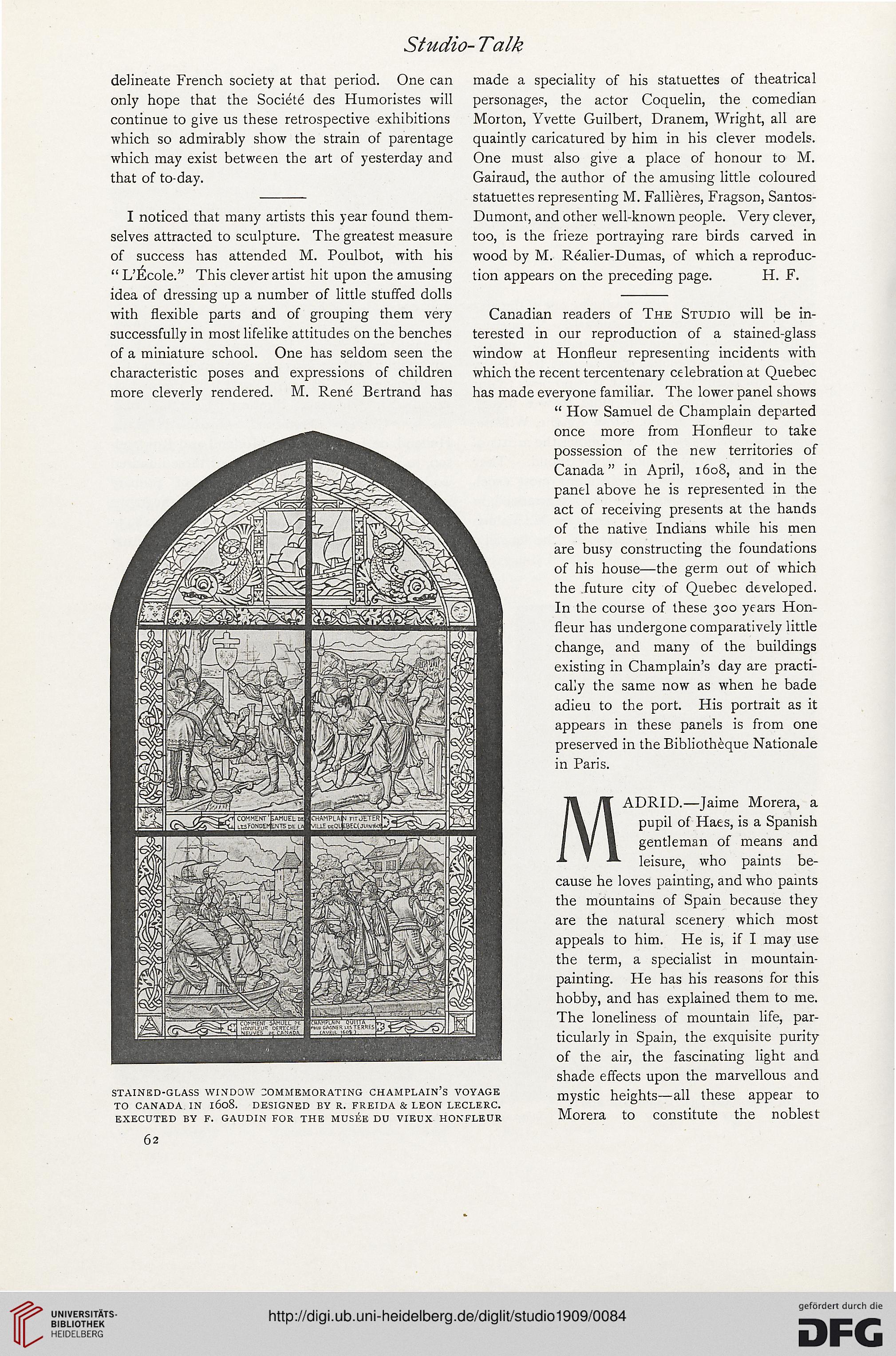Studio- Talk
delineate French society at that period. One can
only hope that the Société des Humoristes will
continue to give us these retrospective exhibitions
which so admirably show the strain of parentage
which may exist between the art of yesterday and
that of to-day.
I noticed that many artists this year found them-
selves attracted to sculpture. The greatest measure
of success has attended M. Poulbot, with his
“ L’École.” This clever artist hit upon the amusing
idea of dressing up a number of little stuffed dolls
with flexible parts and of grouping them very
successfully in most lifelike attitudes on the benches
of a miniature school. One has seldom seen the
characteristic poses and expressions of children
more cleverly rendered. M. René Bertrand has
STAINED-GLASS WINDOW COMMEMORATING CHAMPLAIN’S VOYAGE
TO CANADA IN l6o8. DESIGNED BY R. FREIDA & LEON LECLERC.
EXECUTED BY F. GAUDIN FOR THE MUSÉE DU VIEUX HONFLEUR
MADRID.—Jaime Morera, a
pupil of Haes, is a Spanish
gentleman of means and
leisure, who paints be-
cause he loves painting, and who paints
the mountains of Spain because they
are the natural scenery which most
appeals to him. He is, if I may use
the term, a specialist in mountain-
painting. He has his reasons for this
hobby, and has explained them to me.
The loneliness of mountain life, par-
ticularly in Spain, the exquisite purity
of the air, the fascinating light and
shade effects upon the marvellous and
mystic heights—all these appear to
Morera to constitute the noblest
made a speciality of his statuettes of theatrical
personages, the actor Coquelin, the comedian
Morton, Yvette Guilbert, Dranem, Wright, all are
quaintly caricatured by him in his clever models.
One must also give a place of honour to M.
Gairaud, the author of the amusing little coloured
statuettes representing M. Fallières, Fragson, Santos-
Dumont, and other well-known people. Very clever,
too, is the frieze portraying rare birds carved in
wood by M. Réalier-Dumas, of which a reproduc-
tion appears on the preceding page. H. F.
Canadian readers of The Studio will be in-
terested in our reproduction of a stained-glass
window at Honfleur representing incidents with
which the recent tercentenary celebration at Quebec
has made everyone familiar. The lower panel shows
“ How Samuel de Champlain departed
once more from Honfleur to take
possession of the new territories of
Canada” in April, 1608, and in the
panel above he is represented in the
act of receiving presents at the hands
of the native Indians while his men
are busy constructing the foundations
of his house—the germ out of which
the future city of Quebec developed.
In the course of these 300 years Hon-
fleur has undergone comparatively little
change, and many of the buildings
existing in Champlain’s day are practi-
cally the same now as when he bade
adieu to the port. His portrait as it
appears in these panels is from one
preserved in the Bibliothèque Nationale
in Paris.
62
delineate French society at that period. One can
only hope that the Société des Humoristes will
continue to give us these retrospective exhibitions
which so admirably show the strain of parentage
which may exist between the art of yesterday and
that of to-day.
I noticed that many artists this year found them-
selves attracted to sculpture. The greatest measure
of success has attended M. Poulbot, with his
“ L’École.” This clever artist hit upon the amusing
idea of dressing up a number of little stuffed dolls
with flexible parts and of grouping them very
successfully in most lifelike attitudes on the benches
of a miniature school. One has seldom seen the
characteristic poses and expressions of children
more cleverly rendered. M. René Bertrand has
STAINED-GLASS WINDOW COMMEMORATING CHAMPLAIN’S VOYAGE
TO CANADA IN l6o8. DESIGNED BY R. FREIDA & LEON LECLERC.
EXECUTED BY F. GAUDIN FOR THE MUSÉE DU VIEUX HONFLEUR
MADRID.—Jaime Morera, a
pupil of Haes, is a Spanish
gentleman of means and
leisure, who paints be-
cause he loves painting, and who paints
the mountains of Spain because they
are the natural scenery which most
appeals to him. He is, if I may use
the term, a specialist in mountain-
painting. He has his reasons for this
hobby, and has explained them to me.
The loneliness of mountain life, par-
ticularly in Spain, the exquisite purity
of the air, the fascinating light and
shade effects upon the marvellous and
mystic heights—all these appear to
Morera to constitute the noblest
made a speciality of his statuettes of theatrical
personages, the actor Coquelin, the comedian
Morton, Yvette Guilbert, Dranem, Wright, all are
quaintly caricatured by him in his clever models.
One must also give a place of honour to M.
Gairaud, the author of the amusing little coloured
statuettes representing M. Fallières, Fragson, Santos-
Dumont, and other well-known people. Very clever,
too, is the frieze portraying rare birds carved in
wood by M. Réalier-Dumas, of which a reproduc-
tion appears on the preceding page. H. F.
Canadian readers of The Studio will be in-
terested in our reproduction of a stained-glass
window at Honfleur representing incidents with
which the recent tercentenary celebration at Quebec
has made everyone familiar. The lower panel shows
“ How Samuel de Champlain departed
once more from Honfleur to take
possession of the new territories of
Canada” in April, 1608, and in the
panel above he is represented in the
act of receiving presents at the hands
of the native Indians while his men
are busy constructing the foundations
of his house—the germ out of which
the future city of Quebec developed.
In the course of these 300 years Hon-
fleur has undergone comparatively little
change, and many of the buildings
existing in Champlain’s day are practi-
cally the same now as when he bade
adieu to the port. His portrait as it
appears in these panels is from one
preserved in the Bibliothèque Nationale
in Paris.
62




